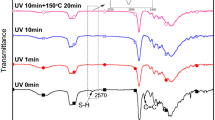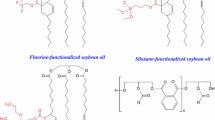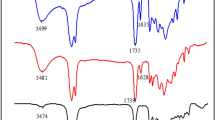Abstract
Novel soy-based thiols and enes were synthesized and characterized. Then, soy-based thiol–ene UV-curable coatings were formulated and their coating physiochemical properties were investigated in detail. The use of biorenewable resources, combined with environmentally friendly UV-curable technology, provides a “green + green” solution to the stricter regulations in the coatings industry. Novel soy-based thiols and enes were synthesized through the Lewis acid-catalyzed ring opening reaction of epoxidized soybean oil with multifunctional thiols or hydroxyl functional allyl compounds. FTIR and NMR confirmed the formation of the target compounds. The soy-based thiols and enes were formulated with petrochemical-based enes and thiols, respectively, to make thiol–ene UV-curable coatings. Typical coating film properties, thermal properties, and photopolymerization kinetics of these coatings were studied. Soy-based thiol–ene coatings having lower functionality thiols and enes have poor UV curability and coating properties, which was attributed to the lower crosslink density. Soy-based thiols and enes with higher functionality can be UV-cured in combination with petrochemical-based enes or thiols even without the presence of free radical photoinitiators. Better coating film properties were obtained from these higher functionality thiol–ene systems that were toughened by commercial hyperbranched acrylates.










Similar content being viewed by others
References
Meier, MAR, Metzger, JO, Schubert, US, “Plant Oil Renewable Resources as Green Alternatives in Polymer Science.” Chem. Soc. Rev., 36 1788–1802 (2007)
Liu, Z, Erhana, SZ, Xu, J, “Preparation, Characterization and Mechanical Properties of Epoxidized Soybean Oil/Clay Nanocomposites.” Polymer, 46 10119–10127 (2005)
Fomin, VA, Guzeev, VV, “Biodegradable Polymers: Status and Prospects.” Plast. Massy, 2 42–48 (2001)
Schroeter, J, “Biodegradable (Plastic) Materials. A Status Report.” Kunststoffe, 90 64–66 (2000)
Mishra, DP, Mahanwar, PA, “Advances in Bioplastic Materials.” Pop. Plast. Packag., 45 68–76 (2000)
Wool, RP, “Development of Affordable Soy-Based Plastics, Resins, and Adhesives.” Chemtech., 29 44–48 (1999)
Gu, H, Ren, K, Martin, D, Marino, T, Neckers, DC, “Cationic UV-Cured Coatings Containing Epoxidized Soybean Oil Initiated by New Onium Salts Containing Tetrakis(pentafluorophenyl)gallate Anion.” J. Coat. Technol., 74 49–52 (2002)
Teng, G, Soucek, MD, “Epoxidized Soybean Oil-Based Ceramer Coatings.” J. Am. Oil Chem. Soc., 77 381–387 (2000)
Masayuki S, Hiroshi, U, Tadashi, H, Nobuo F, Mamoru S, Toppan Printing Co., Ltd., “Polyolefin-Based Adhesive Compositions for Lamination.” JP 99-352849 19991213, 2001.
Lee, SH, Lee, SY, Lim, H, Nam, J, Kye, H, Lee, Y, “Preparation and Properties of Plasticized Cellulose Diacetate Using Triacetine/Epoxidized Soybean Oil.” Polymer (Korea), 30 202–206 (2006)
Ali, SM, Mahmoud, M, Saie, AS, “Mechanical and Thermal Properties of the Plasticized PVC-ESBO.” Iran Polym. J., 14 769–773 (2005)
Choi, JS, Park, WH, “Effect of Biodegradable Plasticizers on Thermal and Mechanical Properties of Poly(3-hydroxybutyrate).” Polym. Test., 23 455–460 (2004)
Adhvaryu, A, Erhan, SE, “Epoxidized Soybean Oil as a Potential Source of High-Temperature Lubricants.” Industr. Crop Product, 15 247–254 (2002)
Hwang, H, Erhan, SE, “Modification of Epoxidized Soybean Oil for Lubricant Formulations with Improved Oxidative Stability and Low Pour Point.” J. Am. Oil Chem. Soc., 78 1179–1184 (2001)
Senyurt, AF, Wei, H, Phillips, B, Cole, M, Nazarenko, S, Hoyle, CE, Piland, SG, Gould, TE, “Physical and Mechanical Properties of Photopolymerized Thiol–Ene/Acrylates.” Macromolecules, 39 6315–6317 (2006)
Lee, T, Roper, TM, Jonsson, ES, Guymon, CA, Hoyle, CE, “Thiol–Ene Photopolymerization Kinetics of Vinyl Acrylate/Multifunctional Thiol Mixtures.” Macromolecules, 37 3606–3613 (2004)
Hoyle, CH, Lee, T, Roper, TM, “Thiol–Enes: Chemistry of the Past with Promise for the Future.” J. Polym. Sci. A, 42 5301–5338 (2004)
Senyurt, AF, Warren, G, Whitehead, JB, Jr, Hoyle, CE, “Matrix Physical Structure Effect on the Electro-Optic Characteristics of Thiol–Ene Based H-PDLC Films.” Polymer, 47 2741–2749 (2006)
Roper, TM, Kwee, T, Lee, T, Guymon, CA, Hoyle, CE, “Photopolymerization of Pigmented Thiol–Ene Systems.” Polymer, 45 2921–2929 (2004)
Cramer, NB, Beckel, ER, Harant, AW, Davies, T, Williamson, DL, Bowman, CN, “Formation of a Host Nanostructure for Ferroelectric Liquid Crystals Using Thiol–Ene Polymers.” Liquid Crystal., 29 1291–1296 (2002)
Li, Y, Birnkrant, MJ, Natarajan, LV, Tondigli, VP, Lloyd, PF, Sutherland, RL, Bunning, TJ, “Polymer Crystallization/Melting Induced Thermal Switching in a Series of Holographically Patterned Bragg Reflectors.” Soft Matter., 1 238–242 (2005)
Cai, J, Shu, W, Yun, L, Jiu, L, “Influence of Reactive Diluents on UV Curing Acrylic Epoxidized Soybean Oil System.” Tuliao Gongye, 36 12–15 (2006)
Bajpai, M, Shukla, V, Singh, DK, Singh, M, Shukla, R, “A Study of the Film Properties of Pigmented UV-Curable Epoxidised Soybean Oil.” Pigment Resin Technol., 33 160–164 (2004)
Desai, D, Rahim, M, Massingill, JL, Jr, “Cationic UV Cured Coatings Using Epoxidized Soybean Oil.” In: Experience the World of UV/EB, RadTech 2000: The Premier UV/EB Conference & Exhibition, Baltimore, MD, United States, pp. 22–44 (2000)
Klang, JA, Radiation Curable Hyperbranched Polyester Acrylates. Sartomer Company, Inc. Exton, PA, USA.
Cramer, NB, Bowman, CN, “Kinetics of Thiol–Ene and Thiol–Acrylate Photopolymerizations with Real-Time Fourier Transform Infrared.” J. Polym. Sci. A, 39 3311–3319 (2001)
Wei, H, Senyurt, AF, Jonsson, S, Hoyle, CE, “Photopolymerization of Ternary Thiol–Ene/Acrylate Systems: Film and Network Properties.” J. Polym. Sci. A, 45 822–829 (2007)
Acknowledgment
We would like to thank the North Dakota Soybean Council for sponsoring this research.
Author information
Authors and Affiliations
Corresponding author
Rights and permissions
About this article
Cite this article
Chen, Z., Chisholm, B.J., Patani, R. et al. Soy-based UV-curable thiol–ene coatings. J Coat Technol Res 7, 603–613 (2010). https://doi.org/10.1007/s11998-010-9241-x
Published:
Issue Date:
DOI: https://doi.org/10.1007/s11998-010-9241-x




